Shany Biton
RawECGNet: Deep Learning Generalization for Atrial Fibrillation Detection from the Raw ECG
Dec 26, 2023



Abstract:Introduction: Deep learning models for detecting episodes of atrial fibrillation (AF) using rhythm information in long-term, ambulatory ECG recordings have shown high performance. However, the rhythm-based approach does not take advantage of the morphological information conveyed by the different ECG waveforms, particularly the f-waves. As a result, the performance of such models may be inherently limited. Methods: To address this limitation, we have developed a deep learning model, named RawECGNet, to detect episodes of AF and atrial flutter (AFl) using the raw, single-lead ECG. We compare the generalization performance of RawECGNet on two external data sets that account for distribution shifts in geography, ethnicity, and lead position. RawECGNet is further benchmarked against a state-of-the-art deep learning model, named ArNet2, which utilizes rhythm information as input. Results: Using RawECGNet, the results for the different leads in the external test sets in terms of the F1 score were 0.91--0.94 in RBDB and 0.93 in SHDB, compared to 0.89--0.91 in RBDB and 0.91 in SHDB for ArNet2. The results highlight RawECGNet as a high-performance, generalizable algorithm for detection of AF and AFl episodes, exploiting information on both rhythm and morphology.
Machine Learning for Ranking f-wave Extraction Methods in Single-Lead ECGs
Jul 17, 2023Abstract:Introduction: The presence of fibrillatory waves (f-waves) is important in the diagnosis of atrial fibrillation (AF), which has motivated the development of methods for f-wave extraction. We propose a novel approach to benchmarking methods designed for single-lead ECG analysis, building on the hypothesis that better-performing AF classification using features computed from the extracted f-waves implies better-performing extraction. The approach is well-suited for processing large Holter data sets annotated with respect to the presence of AF. Methods: Three data sets with a total of 300 two- or three-lead Holter recordings, performed in the USA, Israel and Japan, were used as well as a simulated single-lead data set. Four existing extraction methods based on either average beat subtraction or principal component analysis (PCA) were evaluated. A random forest classifier was used for window-based AF classification. Performance was measured by the area under the receiver operating characteristic (AUROC). Results: The best performance was found for PCA-based extraction, resulting in AUROCs in the ranges 0.77--0.83, 0.62--0.78, and 0.87--0.89 for the data sets from USA, Israel, and Japan, respectively, when analyzed across leads; the AUROC of the simulated single-lead, noisy data set was 0.98. Conclusions: This study provides a novel approach to evaluating the performance of f-wave extraction methods, offering the advantage of not using ground truth f-waves for evaluation, thus being able to leverage real data sets for evaluation. The code is open source (following publication).
ArNet-ECG: Deep Learning for the Detection of Atrial Fibrillation from the Raw Electrocardiogram
Aug 22, 2022
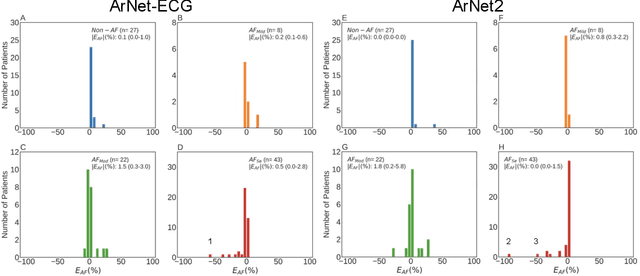


Abstract:Atrial fibrillation (AF) is the most prevalent heart arrhythmia. AF manifests on the electrocardiogram (ECG) though irregular beat-to-beat time interval variation, the absence of P-wave and the presence of fibrillatory waves (f-wave). We hypothesize that a deep learning (DL) approach trained on the raw ECG will enable robust detection of AF events and the estimation of the AF burden (AFB). We further hypothesize that the performance reached leveraging the raw ECG will be superior to previously developed methods using the beat-to-beat interval variation time series. Consequently, we develop a new DL algorithm, denoted ArNet-ECG, to robustly detect AF events and estimate the AFB from the raw ECG and benchmark this algorithms against previous work. Methods: A dataset including 2,247 adult patients and totaling over 53,753 hours of continuous ECG from the University of Virginia (UVAF) was used. Results: ArNet-ECG obtained an F1 of 0.96 and ArNet2 obtained an F1 0.94. Discussion and conclusion: ArNet-ECG outperformed ArNet2 thus demonstrating that using the raw ECG provides added performance over the beat-to-beat interval time series. The main reason found for explaining the higher performance of ArNet-ECG was its high performance on atrial flutter examples versus poor performance on these recordings for ArNet2.
Generalizable and Robust Deep Learning Algorithm for Atrial Fibrillation Diagnosis Across Ethnicities, Ages and Sexes
Jul 20, 2022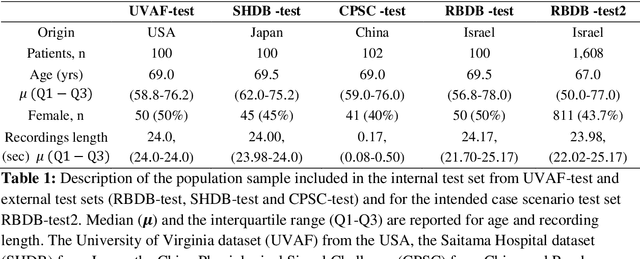
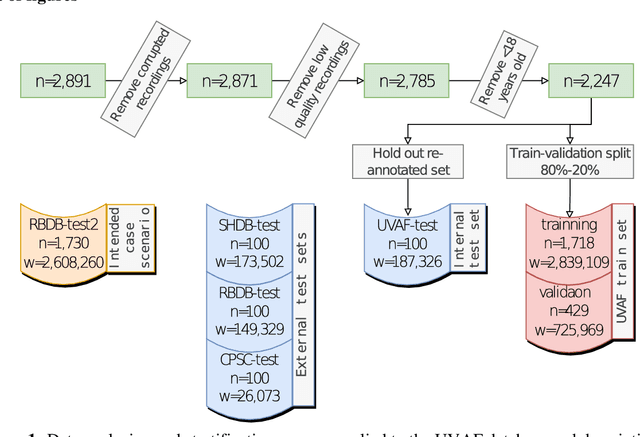
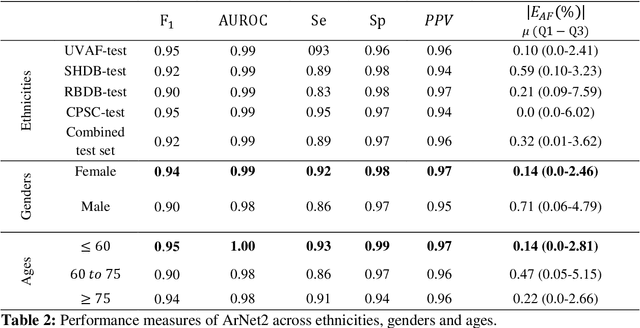
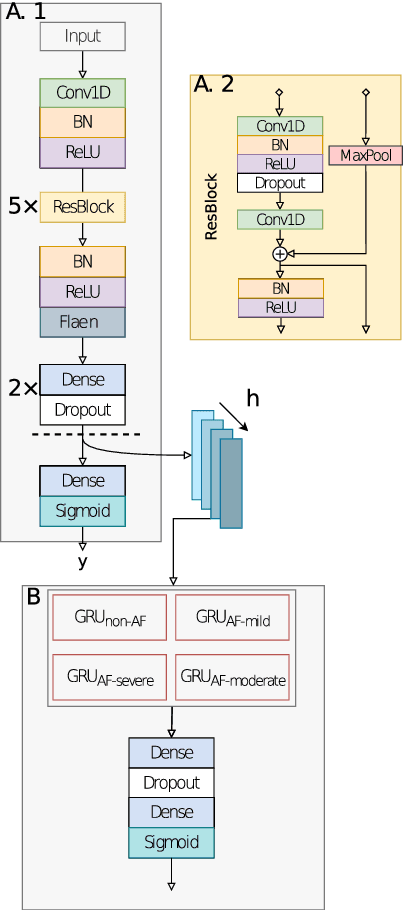
Abstract:To drive health innovation that meets the needs of all and democratize healthcare, there is a need to assess the generalization performance of deep learning (DL) algorithms across various distribution shifts to ensure that these algorithms are robust. This retrospective study is, to the best of our knowledge, the first to develop and assess the generalization performance of a deep learning (DL) model for AF events detection from long term beat-to-beat intervals across ethnicities, ages and sexes. The new recurrent DL model, denoted ArNet2, was developed on a large retrospective dataset of 2,147 patients totaling 51,386 hours of continuous electrocardiogram (ECG). The models generalization was evaluated on manually annotated test sets from four centers (USA, Israel, Japan and China) totaling 402 patients. The model was further validated on a retrospective dataset of 1,730 consecutives Holter recordings from the Rambam Hospital Holter clinic, Haifa, Israel. The model outperformed benchmark state-of-the-art models and generalized well across ethnicities, ages and sexes. Performance was higher for female than male and young adults (less than 60 years old) and showed some differences across ethnicities. The main finding explaining these variations was an impairment in performance in groups with a higher prevalence of atrial flutter (AFL). Our findings on the relative performance of ArNet2 across groups may have clinical implications on the choice of the preferred AF examination method to use relative to the group of interest.
 Add to Chrome
Add to Chrome Add to Firefox
Add to Firefox Add to Edge
Add to Edge